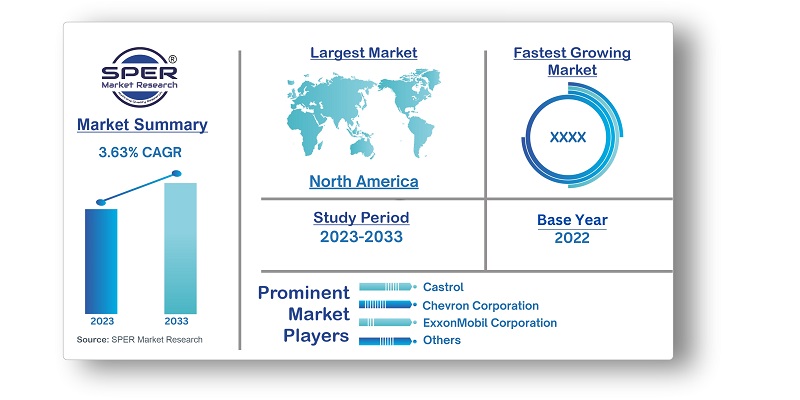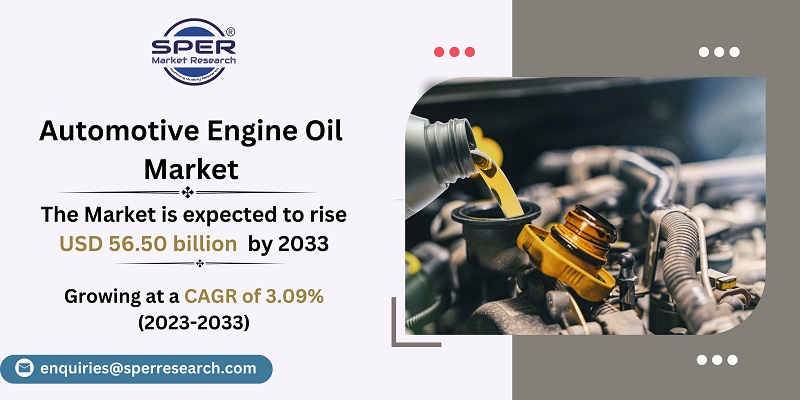
Automotive Engine Oil Market Growth, Size, Trends, Demand, Revenue and Future Opportunities 2033
Global Automotive Engine Oil Market Size- By Type, By Sales Channel, By Engine Type, By Vehicle Type, By Grade- Regional Outlook, Competitive Strategies and Segment Forecast to 2033
| Published: Nov-2022 | Report ID: AMIN2202 | Pages: 1 - 256 | Formats*: |
| Category : Automotive & Transportation | |||
- October 2022: The new engine oil Valvoline All Fleet Turbo Plus (Haulage Expert), from Valvoline Cummins Private Limited, is designed for heavy-duty high-HP tractor use on the road and other related agricultural applications. Through innovation, the company has expanded the range of products it offers.
- September 2022: Chevron said that its expansion project at its Singapore Manufacturing Plant (SMP) was completed. Most of the parts used in additive packages are made by the firm.
- March 2021: By introducing the new Shell Helix Ultra Hybrid oil for Maserati hybrid engines, which offers excellent protection and long-lasting performance, Shell and Maserati expanded their technological and commercial relationship.


| Report Metric | Details |
| Market size available for years | 2019-2033 |
| Base year considered | 2022 |
| Forecast period | 2023-2033 |
| Segments covered | By Type, By Sales Channel, By Engine Type, By Vehicle Type, By Grade. |
| Regions covered | North America, Asia-Pacific, Latin America, Middle East & Africa and Europe |
| Companies Covered | Castrol, Chevron Corporation, ExxonMobil Corporation, Fuchs Petrolub SE, HINDUJA GROUP, Pentagon Lubricants Private Limited, RelaDyne, Royal Dutch Shell plc, Total S.A., Valvoline, Inc. |
- Lubricant Manufacturers and Suppliers
- Oil and Gas Companies,
- Investors and Financial Analyst.
| By Type: |
|
| By Sales Channel: |
|
| By Engine Type: |
|
| By Vehicle Type: |
|
| By Grade: |
|
- Global Automotive Engine Oil Market Size (FY’2023-FY’2033)
- Overview of Global Automotive Engine Oil Market.
- Segmentation of Global Automotive Engine Oil Market By Type (Conventional Engine Oil, High-Mileage Engine Oil, Synthetic Blend Oil, Synthetic Engine Oil).
- Segmentation of Global Automotive Engine Oil Market By Sales Channel (Aftermarket, OEM).
- Segmentation of Global Automotive Engine Oil Market By Engine Type (Alternative Fuel, Diesel, Gasoline).
- Segmentation of Global Automotive Engine Oil Market By Vehicle Type (LCVs, Motorcycles, Passenger Cars).
- Segmentation of Global Automotive Engine Oil Market By Grade (Mineral, Semi-Synthetic, Synthetic).
- Statistical Snap of Global Automotive Engine Oil Market
- Expansion Analysis of Global Automotive Engine Oil Market
- Problems and Obstacles in Global Automotive Engine Oil Market
- Competitive Landscape in the Global Automotive Engine Oil Market
- Impact of COVID-19 and Demonetization on Global Automotive Engine Oil Market
- Details on Current Investment in Global Automotive Engine Oil Market
- Competitive Analysis of Global Automotive Engine Oil Market
- Prominent Players in the Global Automotive Engine Oil Market
- SWOT Analysis of Global Automotive Engine Oil Market
- Global Automotive Engine Oil Market Future Outlook and Projections (FY’2023-FY’2033)
- Recommendations from Analyst
1.1. Scope of the report1.2. Market segment analysis
2.1. Research data source2.1.1. Secondary Data2.1.2. Primary Data2.1.3. SPER’s internal database2.1.4. Premium insight from KOL’s2.2. Market size estimation2.2.1. Top-down and Bottom-up approach2.3. Data triangulation
4.1. Driver, Restraint, Opportunity and Challenges analysis4.1.1. Drivers4.1.2. Restraints4.1.3. Opportunities4.1.4. Challenges4.2. COVID-19 Impacts on the Global Automotive Engine Oil Market
5.1. SWOT Analysis5.1.1. Strengths5.1.2. Weaknesses5.1.3. Opportunities5.1.4. Threats5.2. PESTEL Analysis5.2.1. Political Landscape5.2.2. Economic Landscape5.2.3. Social Landscape5.2.4. Technological Landscape5.2.5. Environmental Landscape5.2.6. Legal Landscape5.3. PORTER’s Five Forces5.3.1. Bargaining power of suppliers5.3.2. Bargaining power of buyers5.3.3. Threat of Substitute5.3.4. Threat of new entrant5.3.5. Competitive rivalry5.4. Heat Map Analysis
6.1. Global Automotive Engine Oil Market Manufacturing Base Distribution, Sales Area, Product Type6.2. Mergers & Acquisitions, Partnerships, Product Launch, and Collaboration in Global Automotive Engine Oil Market
7.1. Global Automotive Engine Oil Market Value Share and Forecast, By Type, 2023-20337.2. Conventional Engine Oil7.3. High-Mileage Engine Oil7.4. Synthetic Blend Oil
7.5. Synthetic Engine Oil
8.1. Global Automotive Engine Oil Market Value Share and Forecast, By Sales Channel, 2023-20338.2. Aftermarket8.3. OEM
9.1. Global Automotive Engine Oil Market Value Share and Forecast, By Engine Type, 2023-20339.2. Alternative Fuel9.3. Diesel9.4. Gasoline
10.1. Global Automotive Engine Oil Market Value Share and Forecast, By Vehicle Type, 2023-203310.2. LCVs10.3. Motorcycles10.4. Passenger Cars
11.1. Global Automotive Engine Oil Market Value Share and Forecast, By Grade, 2023-203311.2. Mineral11.3. Semi-Synthetic11.4. Synthetic
12.1. Global Automotive Engine Oil Market Size and Market Share
13.1. Global Automotive Engine Oil Market Size and Market Share by Type (2019-2026)13.2. Global Automotive Engine Oil Market Size and Market Share by Type (2027-2033)
14.1. Global Automotive Engine Oil Market Size and Market Share by Sales Channel (2019-2026)14.2. Global Automotive Engine Oil Market Size and Market Share by Sales Channel (2027-2033)
15.1. Global Automotive Engine Oil Market Size and Market Share by Engine Type (2019-2026)15.2. Global Automotive Engine Oil Market Size and Market Share by Engine Type (2027-2033)
16.1. Global Automotive Engine Oil Market Size and Market Share by Vehicle Type (2019-2026)16.2. Global Automotive Engine Oil Market Size and Market Share by Vehicle Type (2027-2033)
17.1. Global Automotive Engine Oil Market Size and Market Share by Grade (2019-2026)17.2. Global Automotive Engine Oil Market Size and Market Share by Grade (2027-2033)
18.2. Global Automotive Engine Oil Market Size and Market Share by Region (2027-2033)18.1. Global Automotive Engine Oil Market Size and Market Share by Region (2019-2026)
18.3. Asia-Pacific18.3.1. Australia18.3.2. China18.3.3. India18.3.4. Japan18.3.5. South Korea18.3.6. Rest of Asia-Pacific18.4. Europe18.4.1. France18.4.2. Germany18.4.3. Italy18.4.4. Spain18.4.5. United Kingdom18.4.6. Rest of Europe18.5. Middle East and Africa18.5.1. Kingdom of Saudi Arabia18.5.2. United Arab Emirates18.5.3. Rest of Middle East & Africa18.6. North America18.6.1. Canada18.6.2. Mexico18.6.3. United States18.7. Latin America18.7.1. Argentina18.7.2. Brazil18.7.3. Rest of Latin America
19.1. Castrol19.1.1. Company details19.1.2. Financial outlook19.1.3. Product summary19.1.4. Recent developments19.2. Chevron Corporation19.2.1. Company details19.2.2. Financial outlook19.2.3. Product summary19.2.4. Recent developments19.3. ExxonMobil Corporation19.3.1. Company details19.3.2. Financial outlook19.3.3. Product summary19.3.4. Recent developments19.4. Fuchs Petrolub SE19.4.1. Company details19.4.2. Financial outlook19.4.3. Product summary19.4.4. Recent developments19.5. HINDUJA GROUP19.5.1. Company details19.5.2. Financial outlook19.5.3. Product summary19.5.4. Recent developments19.6. Pentagon Lubricants Private Limited19.6.1. Company details19.6.2. Financial outlook19.6.3. Product summary19.6.4. Recent developments19.7. RelaDyne19.7.1. Company details19.7.2. Financial outlook19.7.3. Product summary19.7.4. Recent developments19.8. Royal Dutch Shell plc19.8.1. Company details19.8.2. Financial outlook19.8.3. Product summary19.8.4. Recent developments19.9. Total S.A.19.9.1. Company details19.9.2. Financial outlook19.9.3. Product summary19.9.4. Recent developments19.10. Valvoline, Inc19.10.1. Company details19.10.2. Financial outlook19.10.3. Product summary19.10.4. Recent developments19.11. Others
SPER Market Research’s methodology uses great emphasis on primary research to ensure that the market intelligence insights are up to date, reliable and accurate. Primary interviews are done with players involved in each phase of a supply chain to analyze the market forecasting. The secondary research method is used to help you fully understand how the future markets and the spending patterns look likes.
The report is based on in-depth qualitative and quantitative analysis of the Product Market. The quantitative analysis involves the application of various projection and sampling techniques. The qualitative analysis involves primary interviews, surveys, and vendor briefings. The data gathered as a result of these processes are validated through experts opinion. Our research methodology entails an ideal mixture of primary and secondary initiatives.



Frequently Asked Questions About This Report
PLACE AN ORDER
Year End Discount
Sample Report
Pre-Purchase Inquiry
NEED CUSTOMIZATION?
Request CustomizationCALL OR EMAIL US
100% Secure Payment






Related Reports
Our Global Clients
Our data-driven insights have influenced the strategy of 200+ reputed companies across the globe.






















